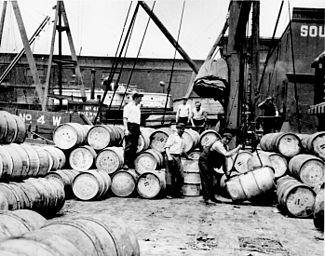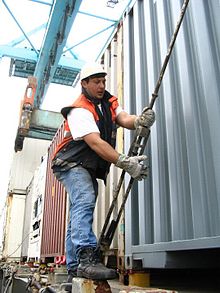- Stevedore
-
"Docker" redirects here. For other uses, see Docker (disambiguation).
 Stevedores on a New York dock loading barrels of corn syrup onto a barge on the Hudson River. Photograph by Lewis Hine, c.1912
Stevedores on a New York dock loading barrels of corn syrup onto a barge on the Hudson River. Photograph by Lewis Hine, c.1912
Stevedore, dockworker, docker, dock labourer, wharfie and longshoreman can have various waterfront-related meanings concerning loading and unloading ships, according to place and country.
The word stevedore originated in Portugal or Spain, and entered the English language through its use by sailors. It started as a phonetic spelling of estivador (Portuguese) or estibador (Spanish), meaning a man who stuffs, here in the sense of a man who loads ships, which was the original meaning of stevedore; compare Latin stīpāre meaning to stuff, as in to fill with stuffing.[1] In the United Kingdom, men who load and unload ships are usually called dockers, while in the United States and Canada the term longshoreman, derived from man-along-the-shore, is used.[2] (Before extensive use of container ships and shore-based handling machinery in the U.S., longshoremen referred exclusively to the dockworkers, while stevedores, in a separate trade union, worked on the ships, operating ship's cranes and moving cargo.) In Canada, the term stevedore has also been used, for example, in the name of the Western Stevedoring Company, Ltd., based in Vancouver, B.C. in the 1950s.[3]
Stevedore has also become common as an appellation for a person who is over-muscular[4] or foulmouthed.[5]
Contents
Loading and unloading ships

Admiralty law History Ordinamenta et consuetudo maris
Amalfian Laws
Hanseatic LeagueFeatures Freight rate · General average
Marine insurance · Marine salvage
Maritime lien · Ship mortgage
Ship registration · Ship transport
ShippingContracts of affreightment Bill of lading · Charter-party Types of charter-party Bareboat charter · Demise charter
Time charter · Voyage charterParties Carrier · Charterer · Consignee
Consignor · Shipbroker · Ship-manager
Ship-owner · Shipper · StevedoreJudiciary Admiralty court
Vice admiralty courtInternational conventions Hague-Visby Rules
Hamburg Rules
Rotterdam Rules
UNCLOS
Maritime Labour ConventionInternational organisations International Maritime Organization
London Maritime Arbitrators AssociationLoading and unloading ships requires knowledge of the operation of loading equipment, the proper techniques for lifting and stowing cargo, and correct handling of hazardous materials. In addition, workers must be physically strong and be able to follow orders.
In earlier days before the advent of containerisation, men who loaded and unloaded ships had to tie down cargoes with rope. A type of stopper knot is called the stevedore knot. The methods of securely tying up parcels of goods is called stevedore lashing or stevedore knotting. While loading a general cargo vessel, they use dunnage, which are pieces of wood (or nowadays sometimes strong inflatable dunnage bags) set down to keep the cargo out of any water that might be lying in the hold or are placed as shims between cargo crates for load securing.
Today, the vast majority of non-bulk cargo is transported in Intermodal containers.[6] The containers arrive at a port by truck, rail or another ship and are stacked in the port's storage area. When the ship that will be transporting them arrives, the containers that it is offloading are unloaded by a crane. The containers either leave the port by truck or rail or are put in the storage area until they are put on another ship. Once the ship is offloaded, the containers it is leaving with are brought to the dock by truck. A crane lifts the containers from the trucks into the ship. As the containers pile up in the ship, the workers connect them to the ship and to each other. The jobs involved include the crane operators, the workers who connect the containers to the ship and each other, the truck drivers that transport the containers from the dock and storage area, the workers who track the containers in the storage area as they are loaded and unloaded, as well as various supervisors. Those workers at the port who handle and move the containers are likely to be considered stevedores or longshoremen.
Because they work outdoors in all types of weather, these workers adopted a type of cap that has a snug fit, is warm, and is easily put away in a pocket. These are a type of beanie or watch cap called variously stevedore's cap or stevedore's hat.
Before containerization, freight was often handled with a longshoreman’s hook, a tool which became emblematic of the profession (Mostly on the west coast of the United States and Canada).[7]
Traditionally, stevedores would have no fixed job and turn up at the docks in the morning hoping to find someone willing to employ them for the day. London dockers called this practice "standing on the stones",[8] while in the United States it was referred to as Shaping.[9] In Britain, due to changes in employment laws, such jobs have either become permanent or have been converted to temporary jobs.[citation needed]
Dock workers have been a prominent part of the modern labor movement.[10]
Usage
Australia
In Australia, stevedores or dockers were historically referred to as wharf labourers or waterside workers, and were colloquially called "wharfies". The Maritime Union of Australia has coverage of these workers, and fought a substantial industrial battle in the 1998 Australian waterfront dispute to prevent the contracting out of work to non-union contractors. The term "Docker" is in modern colloquial use, as evidenced by the port-based Fremantle Football Club's official nickname of the "Freo Dockers" although the term "wharfie" is still more commonly used in other states.
New Zealand
New Zealand usage is highly similar to the Australian version; "waterside workers" are also known as "wharfies." The 1951 New Zealand waterfront dispute, involving New Zealand stevedores, was the largest and most bitter industrial dispute in the country's history.
United States
In usual present-day United States waterfront word usage, a stevedore is a man or a company who manages the operation of loading or unloading a ship. A stevedore typically owns equipment used in the loading or discharge operation and hires longshoremen who load and unload cargo under the direction of a stevedore superintendent.This type of work along the East Coast water front was characteristic for such port like New York, Boston, or Philadelphia. However, the port of Baltimore, unlike the ports of New York or Boston, which were dominated by Irish and German immigrants, hired mostly stevedores and longshoremen who were overwhelmingly Polish. In the 1930s, about eighty percent of the Baltimore's longshoremen were Polish or of Polish descent.[11] The port of Baltimore had an international reputation of fast cargo handling credited to the well-organized gang system that was nearly free of corruption, wildcat strikes, and constant work stoppages of its other East coast counterparts. In fact, the New York Anti-Crime Commission and the Waterfront Commission of New York looked upon the Baltimore system as the ideal one for all ports. The hiring of longshoremen in Baltimore by the gang system dates back to 1913, when the ILA was first formed.
The Polish longshoremen began setting up the system by selecting the most skilled men to lead them. This newly formed gang would usually work for the same company, which would give the priority to the gang. During the times where there was no work within the particular company, the gang would work elsewhere, or even divide to aid other groups in their work, which would speed up the work and would make it more efficient[12] In an environment as dangerous as a busy waterfront, Baltimore's gangs always operated together as a unit, because the experience let them know what each member would do at any given time making a water front a much safer place.[13] At the beginning of the Second World War Polish predominance in the Port of Baltimore would significantly diminish as many Poles left to fight the war.
It is common but inaccurate to use the terms “stevedore” and “longshoreman” interchangeably.[12] However, even the U.S. Congress has done so in the Ship Mortgage Act, 46 app. U.S.C. section 31301(5)(C) which designates both "crew wages" and "stevedore wages" as preferred maritime liens. The intent of the statute was to give the wages of the seamen and longshoremen the same level of protection. Nevertheless, sometimes the word "stevedore" is still used to mean "man who loads and unloads a ship", as British "docker".
Today, a commercial stevedoring company also may contract with a terminal owner to manage all terminal operations. Many large container ship operators have established in-house stevedoring operations to handle cargo at their own terminals and to provide stevedoring services to other container carriers.
Two unions within the AFL-CIO represent longshoremen in the United States: the International Longshoremen's Association, which represents longshoremen on the East Coast, on the Great Lakes and connected waterways and along the Gulf of Mexico, and the International Longshore and Warehouse Union, which represents longshoremen along the West Coast, in Hawaii and Alaska, and, through an affiliate, in Canada.
United Kingdom
In the United Kingdom, the definition of a stevedore varies from port to port. In some ports, only the highly skilled master of a loading gang is referred to as a "stevedore". "Docker" is the usual general term used in the UK for a man who loads or unloads ships and performs various other jobs required at a sea port.
19th century
In Two Years Before the Mast the author describes the steeving of a merchant sailing ship. This was the process of taking a mostly-full hold and cramming in more material. In this case, the hold was filled with hides from the California hide trade up to four feet below the deckhead (equivalent of 'ceiling'). "Books" composed of 25-50 cattle skins folded into a bundle were prepared, and a small opening created in the middle of one of the existing stacks. Then the book was shoved in by use of a pair of thick strong pieces of wood called steeves. The steeves had one end shaped as a wedge which was placed into the middle of a book to shove it into the stack. The other ends were pushed on by means of block and tackle attached to the hull and overhead beams and hauled on by sailors.
Stevedores
 A docker lashes down cargo aboard a container ship.
A docker lashes down cargo aboard a container ship.
Former stevedores and longshoremen include:
- Frithjof Bergmann - philosopher
- Mestre Bimba - founder of the Regional style of Capoeira
- Ronald Bird -
- Jerry Colonna - Movie actor/comedian.*
- Terry Bollea - Better known as professional wrestler Hulk Hogan
- Murray Bookchin - American libertarian socialist, founder of social ecology
- Harry Bridges - founder of the International Longshore and Warehouse Union (ILWU)
- James Braddock - heavyweight boxing champion from 1935 to 1937.
- Jack Dash British Dock Workers Trade Union Leader
- Chief Dan George - Native American actor
- Danny Greene - Irish American Mobster
- David Hall -
- Eric Hoffer - author and philosopher
- Brian Jacques - author of the Redwall book series
- Vladimir Kokkinaki - the most famous test pilot in the Soviet Union
- Mauno Koivisto - President of Finland from 1982 to 1994
- Artie Lange - comedian/radio personality, The Howard Stern Show
- Tom Mann - British trade unionist and organizer of the London Dock Strike of 1889
- Charles Manson - convicted murderer, worked as a longshoreman from 1954–1956
- Frank McCourt - noted Irish-American author
- Daniel Patrick Moynihan - sociologist, Ambassador to the United Nations and to India, U.S. Senator
- Bruce Nelson - labor historian, author of Workers on the Waterfront
- Charles Plymell - poet
- James Rogers -
- Joe Rollino - boxer and strongman
- Glenn Theodore Seaborg - 1951 Nobel Prize Winner, member of The Manhattan Project [14]
- Hubert Selby, Jr. - Writer, Last Exit To Brooklyn
- Mark E. Smith - singer/songwriter of the British band The Fall
- Stan Weir - blue-collar intellectual and sociologist, founder of Singlejack Press
- Tobias Winston -
- Isaac Woodard - African-American victim of a notorious racist attack
- J. S. Woodsworth - a founder of the Cooperative Commonwealth Federation, the forerunner of the New Democratic Party of Canada
Popular media
- In 1949, reporter Malcolm Johnson was awarded a Pulitzer Prize for a 24-part investigative series titled Crime on the Waterfront published in the New York Sun. This material was fictionalized and used as a basis for the influential film, On the Waterfront, starring Marlon Brando as a longshoreman, and the working conditions on the docks figure significantly in the film's plot. Playwright Arthur Miller was involved in the early stages of the development of the film, and his play A View from the Bridge also deals with the troubled life of a longshoreman.
- In the HBO Series The Wire, the Stevedore Union and its members, particularly Frank Sobotka, working in Baltimore figure prominently in the second season's story arc.
- In the song by Jimmy Nail, Big River there is the line, "Now all the capstans and the cargo boats and stevedores are gone."
See also
- Battle of Ballantyne Pier (Canada)
- Dockers' Union (UK) (disambiguation)
- Admiralty law
- Dunnage
- Federated Ship Painters and Dockers Union
- International Longshore and Warehouse Union (United States)
- Liverpool Dockers' Strike (UK)
- Mersey Docks and Harbour Company
- National Union of Dock Labourers
- Scottish Union of Dock Labourers
- Weeks Marine
Further reading
- Arnesen, Eric. Waterfront Workers of New Orleans: Race, Class, and Politics, 1863-1923 (1994) excerpt and text search
- Connolly. Michael C. Seated by the Sea: The Maritime History of Portland, Maine, and Its Irish Longshoremen (University Press of Florida; 2010) 280 pages
- Davis, Colin J. Waterfront Revolts: New York and London Dockworkers, 1946-61 (2003)
- Land, Isaac. "Liberty on the Waterfront: American Maritime Culture in the Age of Revolution," Journal of Social History, Spring 2007, Vol. 40 Issue 3, pp 731–743
- Mello, William J. New York Longshoremen: Class and Power on the Docks (2010)
- Nelson, Bruce. Workers on the Waterfront: Seamen, Longshoremen, and Unionism in the 1930s (1990)
- Parnaby, Andrew. Citizen Docker: Making a New Deal on the Vancouver Waterfront, 1919-1939 (2008)
- Phillips, Jim. "Class and Industrial Relations in Britain: The ‘Long’ Mid-century and the Case of Port Transport, c. 1920–70," Twentieth Century British History, March 2005, Vol. 16 Issue 1, pp 52-73
- Safford, Jeffrey J. "The Pacific Coast Maritime Strike of 1936: Another View," Pacific Historical Review Nov 2008, Vol. 77 Issue 4, pp 585–615
- Vaughan Wilson, Matt. "The 1911 Waterfront Strikes in Glasgow: Trade Unions and Rank-and-File Militancy in the Labour Unrest of 1910-1914," International Review of Social History, Aug 2008, Vol. 53 Issue 2, pp 261–292
- Velasco e Cruz, Maria Cecília. "Puzzling Out Slave Origins in Rio de Janeiro Port Unionism: The 1906 Strike and the Sociedade de Resistência dos Trabalhadores em Trapiche e Café," Hispanic American Historical Review, May 2006, Vol. 86 Issue 2, pp 205–245
Notes
- ^ Freedictionary.com
- ^ America on the Move collection
- ^ Paul Hellyer Papers, Library and Archives Canada, MG32 B33, Vol. 251.
- ^ http://www.bewilderingstories.com/issue253/botanist3.html http://www.theautochannel.com/vehicles/new/reviews/gap9635.html http://twobraincells.blogspot.com/2004_04_04_archive.html
- ^ http://www.stjamesaus.org/Sermons/SermonDisplay.asp?ID=137 http://www.ideablade.com/techtip_the_document_outline_window.htm
- ^ Marc Levinson (2006). The Box, How the Shipping Container Made the World Smaller and the World Economy Bigger. Princeton Univ. Press. ISBN 0-691-12324-1. http://www.pupress.princeton.edu/titles/8131.html.
- ^ (1969) "Uniform Containerization of Freight: Early Steps in the Evolution of an Idea", The Business History Review, 43(1), pp. 84-87
- ^ standing on the stones BFI Film and TV Database, London Dockers (1964)
- ^ "Shaping". Random House Unabridged Dictionary. http://dictionary.reference.com/browse/shape%20up. Retrieved 2008-05-15.
- ^ BBC British History
- ^ Hollowak, Thomas L. A History of Polish Longshoremen and Their Role in the Establishment of a Union at the Port of Baltimore. Baltimore: Historyk Press, 1996.
- ^ a b Delich, Helen.Noted for Fast, Efficient Work Baltimore System of Operating is Termed Ideal for All Ports. Baltimore Sun, 1955.
- ^ Delich, Helen.Ganging Up on the Water Front. Baltimore Sun, 1954.
- ^ http://www.lbl.gov/Science-Articles/Archive/seaborg-tribute.html
External links
- MTL Dockers Strike (Ireland)
- Moynihan of the Moynihan Report
- DockWork.be,the Port of Antwerp in pictures, maritime website with portpictures taken by an Antwerp dockworker.
Categories:- Marine occupations
- Portuguese loanwords
Wikimedia Foundation. 2010.
